-
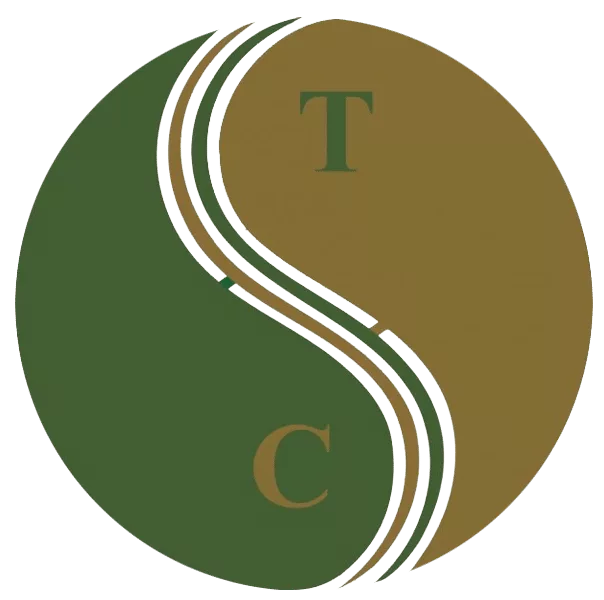 Art of Wellness Acupuncture & Traditional Chinese Medicine (TCM)11704 Wilshire Blvd, Suite 295, Los Angeles, CA, 90025
Art of Wellness Acupuncture & Traditional Chinese Medicine (TCM)11704 Wilshire Blvd, Suite 295, Los Angeles, CA, 90025
myartofwellness@gmail.com310-451-5522 Office Hours
MonClosedTue7:30 am --4 pmWed7:30 am --4 pmThu7:30 am -- 4 pmFri7:30 am -- 4 pmSat7:30 am -- 4 pmSunClosedOur office opens from Tuesdays to Saturdays 7:30 am to 4 pm, will be closed on Memorial day, Independent day, Labor day, Thanksgiving day, Christmas and New year.
-
Recent Posts
- How to Treat Nerve Pain With Acupuncture and TCM
- How to Treat Watery Eyes With Acupuncture and TCM
- How to Treat Ovarian Cysts With Acupuncture and TCM
- How to Treat Dystonia With Acupuncture and TCM
- Can Acupuncture Help Bad Breath?
- How to Treat Atopy with Acupuncture and TCM
- Plantar Fasciosis Treatment With Acupuncture and TCM
- How to Protect Yourself When Air Quality Is Poor
- How to Treat Spinal Headache With Acupuncture and TCM
- How to Treat Sarcoidosis With Acupuncture and TCM
- How to Treat Flu With Acupuncture and TCM
- Chinese New Year 2025 Year of the Snake
- How to Treat Lumbar Stenosis With Acupuncture and TCM
- How to Treat Wrist Pain With Acupuncture and TCM
- How to Treat Cervical Radiculopathy With Acupuncture and TCM
- How To Treat Frozen Shoulder With Acupuncture and TCM
- Sign up to receive news and updates and get my free report:“The Top 10 Reasons to Try Acupuncture”

May 2025 M T W T F S S 1 2 3 4 5 6 7 8 9 10 11 12 13 14 15 16 17 18 19 20 21 22 23 24 25 26 27 28 29 30 31
Uncategorized
How to Treat Nerve Pain With Acupuncture and TCM
By Qineng Tan, L.Ac., Ph.D. and Xiaomei Cai, L.Ac., Ph.D.
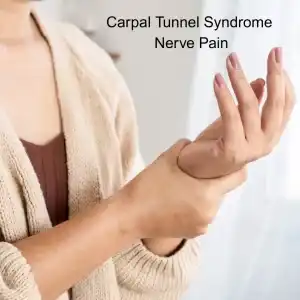
Struggling with sharp, burning, or tingling pain? Do your hands or feet feel numb or hypersensitive? Nerve pain—also called neuropathic pain—can be relieved with acupuncture treatment and other TCM modalities.
Nerve pain occurs when nerves are damaged or dysfunctional, sending incorrect pain signals to the brain. Unlike pain caused by injury or inflammation, nerve pain can persist without an obvious cause and may not respond well to common pain relievers.
Nerve pain can interfere with your ability to work, sleep, or enjoy your day-to-day life. The good news is that acupuncture can be an effective way to treat nerve pain.
What Causes Nerve Pain?
There are many possible underlying conditions that can lead to nerve pain. Here are some of the 10 most most common causes of nerve pain:
- Peripheral neuropathy – often due to diabetes, chemotherapy, or alcohol use
- Trigeminal neuralgia – intense facial pain due to nerve irritation
- Occipital neuralgia – shooting pain at the back of the head and neck
- Cervical radiculopathy – pinched nerves in the neck causing radiating pain
- Carpal tunnel syndrome – pressure on the median nerve in the wrist
- Spinal stenosis or Lumbar stenosis – narrowing of the spinal canal that compresses nerves
- Sciatica – pain radiating down the leg due to sciatic nerve irritation
- Postherpetic neuralgia – lingering nerve pain after shingles
- Dystonia and other movement disorders – can involve nerve dysfunction
- Multiple sclerosis and other autoimmune diseases – affecting nerve conduction
Medical Treatment for Nerve Pain
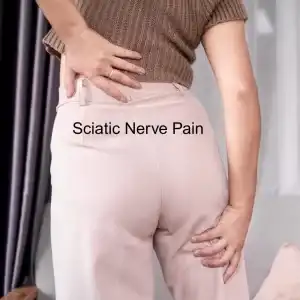
In Western medicine, the diagnostic process for nerve pain typically begins with a detailed health history and physical examination, focusing on neurological function. Physicians may conduct reflex tests, strength assessments, and evaluate your sensory response. Imaging tests such as MRI or CT scans can help identify structural causes like herniated discs or spinal stenosis. Nerve conduction studies and electromyography (EMG) may be used to assess how well the nerves and muscles are functioning.
Once nerve pain is diagnosed, treatment often involves medications aimed at disrupting the abnormal pain signals. Doctors may prescribe anticonvulsant drugs like gabapentin or pregabalin, which were originally developed to treat epilepsy but are now commonly used to relieve nerve pain.
Certain antidepressants, such as amitriptyline or duloxetine, are also frequently used—not for their mood-enhancing effects, but because they influence how the nervous system processes pain. In some cases, opioids may be prescribed, though they are generally considered a last resort due to the risk of dependence and side effects.
Topical treatments like lidocaine patches or capsaicin cream may offer localized relief for some people. Corticosteroid injections may be recommended if inflammation is contributing to nerve compression, such as in cases of radiculopathy or carpal tunnel syndrome.
Physical therapy can be useful for improving strength, mobility, and nerve function, especially when musculoskeletal imbalances are part of the problem. In more severe cases—such as when a nerve is severely compressed or damaged—surgical intervention may be considered.
While these treatments can sometimes provide temporary relief, they may not address the root cause of nerve dysfunction. Additionally, many patients find that medications come with undesirable side effects or offer only partial relief. That’s why more and more people are turning to acupuncture and Traditional Chinese Medicine (TCM) as a complementary or alternative solution for managing nerve pain holistically.
Can Acupuncture Help Nerve Pain?
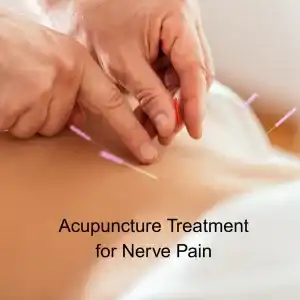
In the Western medical model, nerve pain—also called neuropathic pain—is typically understood as the result of damage or dysfunction within the nervous system. This could be due to injury, chronic conditions like diabetes, infections such as shingles, or musculoskeletal issues like spinal stenosis or herniated discs.
TCM, on the other hand, views nerve pain through a holistic lens, focusing on the flow of energy—known as Qi—through the body’s channels or meridians. In this system, pain is often caused by Qi and blood stagnation, which leads to blockages along these pathways. This stagnation can arise from a deficiency in the liver or kidney systems, which in TCM are believed to support and nourish the body’s nerves.
External influences like wind, cold, or dampness may also disrupt the body’s internal balance, leading to symptoms such as numbness, tingling, or sharp, radiating pain. Instead of targeting only the site of discomfort, TCM aims to correct underlying imbalances and restore smooth, harmonious flow throughout the body.
Treatment for nerve pain in TCM often involves acupuncture to stimulate specific points that promote circulation and healing. Herbal medicine is frequently used in combination, with formulas designed to nourish blood, strengthen the liver and kidneys, and dispel pathogenic factors. Other traditional therapies, such as moxibustion (a warming technique using mugwort) or cupping, may be applied to enhance circulation and relieve tension. TCM practitioners also offer guidance on diet, lifestyle, and emotional health to support the body’s natural healing processes and prevent further pain episodes.
A 2023 meta-analysis of 16 studies involving over 1,000 patients with neuropathic pain found that acupuncture significantly reduced pain intensity compared to sham or no treatment.
Acupuncture can modulate receptors and ion channels in peripheral nerves, reducing spontaneous nerve activity that leads to pain.
Studies have shown that acupuncture stimulates the release of neurotrophic factors like nerve growth factor (NGF) and brain-derived neurotrophic factor (BDNF), which support nerve regeneration and repair.
Acupuncture Near Me for Nerve Pain in West Los Angeles
If you’re struggling with nerve pain and looking for a natural, holistic approach to healing, acupuncture and Traditional Chinese Medicine may offer the relief you’ve been hoping for. At Art of Wellness Acupuncture in West Los Angeles, we specialize in helping patients manage complex, chronic pain conditions by addressing the root causes—not just the symptoms. Whether your nerve pain stems from an injury, a chronic condition, or something undiagnosed, we’ll work with you to develop a personalized treatment plan that supports your body’s natural healing processes. Don’t let nerve pain control your life—reach out today to schedule a consultation and take the first step toward lasting relief.
*This article is for education from the perspective of Traditional Chinese Medicine only. The education provided by this article is not approved by FDA to diagnose, prevent, treat and cure human diseases. It should not stop you from consulting with your physician for your medical conditions. Traditional Chinese Medicine is based on Qi, which is an invisible force that usually cannot be observed by modern science. Because science focuses on testing ideas about the natural world with evidence obtained through observation, these aspects of acupuncture can’t be studied by science. Therefore acupuncture and Chinese herbs are often not supported by double-blind, randomized trials, and they are considered alternative medicine therapies in the United States.
How to Treat Watery Eyes With Acupuncture and TCM
By Qineng Tan, L.Ac., Ph.D. and Xiaomei Cai, L.Ac., Ph.D.
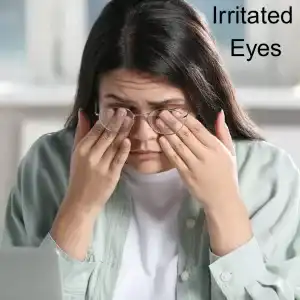
Watery eyes, also known as excessive tearing or epiphora, can be a frustrating and uncomfortable symptom, especially when paired with itchiness, redness, burning, or blurry vision. For many people, this problem flares up seasonally due to allergies, while others deal with chronically runny eyes year-round.
In Traditional Chinese Medicine (TCM), watery eyes are a signal that the body is out of balance. Acupuncture and Chinese herbal medicine can help relieve discomfort, and get to the root cause of why your eyes won’t stop watering.
What Causes Watery Eyes?
Watery eyes can stem from a variety of different health issues, ranging from environmental factors to chronic conditions. Some of the most common causes of water eyes include:
- Seasonal allergies (allergic conjunctivitis) – One of the most common causes of itchy, watery eyes, especially in spring (hay fever) and fall. Pollen, grasses, and other airborne allergens trigger inflammation in the eyes.
- Dry eye syndrome – Ironically, overly dry eyes often produce excess tears as a reflex.
- Blocked tear ducts – A blockage in the tear drainage system causes tears to back up and spill over the lower eyelid.
- Eye infections – Pink eye (conjunctivitis), blepharitis (inflammation of the eyelid), or other infections can trigger watery discharge.
- Irritants – Smoke, wind, strong odors, dust, or chemical exposure can cause the eyes to tear up.
- Aging – Tear production and drainage efficiency change with age, increasing the likelihood of both dry eyes and tearing.
- Eyelid problems – Conditions like ectropion (outward-turning eyelid) or entropion (inward-turning eyelid) can interfere with proper tear drainage.
- Autoimmune disorders – Conditions such as Sjögren’s syndrome can affect tear glands and eye moisture.
- Refractive surgeries or contact lens irritation – These may alter tear film stability or increase sensitivity.
Conventional Treatment for Watery Eyes
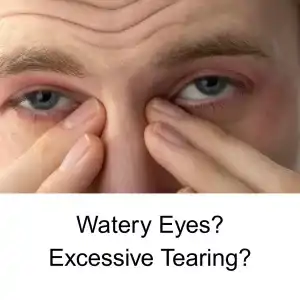
In Western medicine, diagnosing watery eyes typically involves an eye exam with a focus on tear production, drainage, and any signs of irritation or inflammation. Tests may include a Schirmer test to measure tear production,Fluorescein staining to assess eye surface health, and/or dye tests to evaluate tear duct function.
Treatments depend on the underlying cause and may include:
- Antihistamines or corticosteroid eye drops for allergies
- Artificial tears or lubricating drops for dry eye syndrome
- Warm compresses and eyelid scrubs for blepharitis
- Antibiotics for infections
- Surgical procedures to correct blocked tear ducts or eyelid malposition
While many people find temporary relief through these treatments, they may not always resolve chronic watery eyes or recurring eye infections. Acupuncture and Traditional Chinese Medicine can offer another, more holistic approach.
TCM Theory – Root Causes of Watery Eyes
In Traditional Chinese Medicine, the eyes are known as “the windows of the Liver.” This doesn’t refer to the physical liver as we usually think of it in Western anatomy, but rather the Liver organ system in TCM theory, which is responsible for storing blood and ensuring the smooth flow of Qi (vital energy) throughout the body.
The Liver is closely connected to the eyes, so any imbalance in Liver Qi or Liver Blood can show up as eye issues—blurriness, dryness, sensitivity, itchiness, or excessive tearing.
Other contributing factors may include:
- Liver Wind or Liver Heat – These patterns can manifest as itchy, red, or irritated eyes, often seen with allergies.
- Kidney Yin Deficiency – When the body’s fluids are deficient, this can lead to dry eye syndrome with reflex tearing.
- Spleen Qi Deficiency – Leads to poor fluid transformation, which may cause congestion or excess dampness.
- External Wind or Heat pathogens – Allergens or environmental irritants can invade the body and disrupt the balance of the organ systems, causing acute symptoms like watery, itchy eyes.
Can Acupuncture Help Watery Eyes?
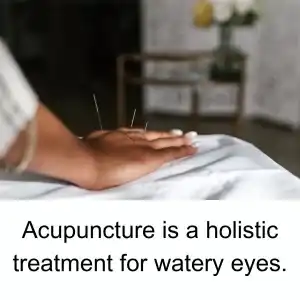
A TCM practitioner will take a thorough health history and examine your tongue, pulse, and symptoms to determine the root cause of your watery eyes. A treatment protocol may include acupuncture to balance Liver Qi, clear Wind and Heat, and improve fluid metabolism, Chinese herbal formulas to nourish Liver and Kidney systems or clear Dampness and Heat, and dietary therapy to reduce phlegm or support Yin and Blood.
Your acupuncturist will also recommend dietary adjustments that can help clear excess liver heat, such as mung beans, dark, seaweed, arugula, celery, grass fed beef and liver, organic fertile eggs, flax oil, and sesame seeds.
For liver health, is it usually best to avoid alcohol, fried foods, sugar, processed foods, cashews and peanuts, and nightshade vegetables like eggplant and bell peppers.
A randomized controlled trial examined the efficacy of acupuncture in treating dry eye syndrome, a condition that can paradoxically cause reflex tearing. Participants receiving acupuncture reported significant improvements in tear film stability and symptom relief compared to the control group.
A clinical study published in the Journal of Traditional Chinese Medicine investigated the effects of acupuncture on 34 patients suffering from epiphora due to lacrimal duct dysfunction. The treatment involved specific acupuncture protocols aimed at restoring proper tear drainage. The results indicated significant improvement in symptoms, suggesting that acupuncture can be an effective non-invasive treatment for certain types of excessive tearing.
By restoring balance to the underlying systems involved—especially the Liver—TCM not only helps reduce excessive tearing but can also address related symptoms like eye fatigue, itching, redness, and even headaches.
Acupuncture Near Me for Watery Eyes in West Los Angeles
If you’re struggling with constant tearing, itchy eyes, or other irritating symptoms related to allergies, dry eyes, or sinus issues, acupuncture and Traditional Chinese Medicine may offer the relief you’ve been looking for. At Art of Wellness Acupuncture in West Los Angeles, we take a whole-body approach to treating eye conditions by restoring balance and improving circulation through personalized acupuncture treatments and herbal support. Whether your symptoms are seasonal or persistent, don’t hesitate to reach out for a consultation.
*This article is for education from the perspective of Traditional Chinese Medicine only. The education provided by this article is not approved by FDA to diagnose, prevent, treat and cure human diseases. It should not stop you from consulting with your physician for your medical conditions. Traditional Chinese Medicine is based on Qi, which is an invisible force that usually cannot be observed by modern science. Because science focuses on testing ideas about the natural world with evidence obtained through observation, these aspects of acupuncture can’t be studied by science. Therefore acupuncture and Chinese herbs are often not supported by double-blind, randomized trials, and they are considered alternative medicine therapies in the United States.
How to Treat Ovarian Cysts With Acupuncture and TCM
By Xiaomei Cai, L.Ac., Ph.D. and Qineng Tan, L.Ac. Ph.D.

Sharp pain lower abdomen? Feeling bloated or heavy? Pain during intercourse? These can all be signs of an ovarian cyst. Acupuncture and TCM can help relieve pain in lower left abdomen or sharp pain lower right abdomen, while also addressing the root cause of ovarian cysts.
Ovarian cysts are fluid-filled sacs that develop on or within an ovary. These cysts are quite common and often form naturally during the menstrual cycle. While many ovarian cysts are harmless and resolve on their own without causing symptoms, some can lead to pain and may indicate underlying health issues.
TCM has centuries-old methods of helping to regulate women’s hormonal health and offers natural solutions for reproductive care, especially focusing on ovarian health.
Symptoms of Ovarian Cysts
Many people may have ovarian cysts without knowing it, because they do not always cause painful symptoms. However, sometimes a cyst can cause a lot of pain, or may cause pain and bloating that comes and goes during different phases of the menstrual cycle, or due to other factors.
- Pelvic Pain, dull or sharp ache in the lower abdomen, often on one side: ache in lower left abdomen, lower left hand abdominal pain, pain in lower right abdomen.
- Bloating, feeling of fullness or heaviness in the abdomen.
- Pain During Intercourse, discomfort during sexual activity.
- Menstrual irregularities, unusual bleeding patterns, including heavier or lighter periods
- Frequent urination, increased urge to urinate due to pressure on the bladder.
- Constipation, difficult bowel movements.
- Nausea, vomiting, especially if a cyst causes the ovary to twist (ovarian torsion)
Ovarian Cyst Diagnosis and Treatment

In Western medicine, ovarian cysts are typically diagnosed through a pelvic examination followed by imaging studies such as ultrasound, which helps determine the cyst’s size, shape, and composition. Additional tests like blood work may be conducted to assess hormone levels or rule out malignancy.
Sometimes the ovary and/or fallopian tube becomes twisted and is pulling on surrounding tissues; this is called ovarian torsion. This cuts off circulation to the ovary, which not only can cause severe pain, but can lead to the “death” of the ovary. This is a serious condition, which requires surgery to untwist or remove the ovary and sometimes the fallopian tube.
When there is no ovarian torsion, the treatment for a cyst will usually involve a wait and see approach, monitoring the cyst over time to see if it resolves naturally, especially if it’s small and asymptomatic.
Hormonal contraceptives may be prescribed to prevent the formation of new cysts, though they won’t shrink existing ones.
In cases where cysts are large, persistent, or causing significant discomfort, surgical removal may be recommended. Procedures range from minimally invasive laparoscopic surgery to more extensive laparotomy, depending on the cyst’s characteristics and suspicion of malignancy.
TCM and acupuncture offer alternative approaches to treating ovarian cysts, focusing on restoring balance.
Can Acupuncture Help Ovarian Cysts?

If you are experiencing serious pain in the left lower quadrant or right lower quadrant, it is important to seek urgent medical care and diagnostics, because ovarian torsion can, in some cases, lead to a rupture and even possibly life-threatening sepsis.
However, in many cases, an enlarged cyst can be helped with complementary therapy with acupuncture and other TCM treatment for cysts.
In TCM, we do not just look at treating the symptoms of a cyst that has already formed. We dig deeper to look at the reasons why cysts are developing on the ovaries. Acupuncture offers a multifaceted approach to treating ovarian cysts by addressing underlying imbalances and promoting the body’s natural healing processes.
A comprehensive treatment protocol for ovarian cysts may include:
- Electro-Acupuncture: By identifying the precise location of the cyst through palpation or medical imaging, practitioners can apply electro-acupuncture directly to the affected area. This involves inserting needles into specific abdominal and lower back points and administering electrical stimulation for approximately 30 minutes, aiming to reduce the cyst’s size and alleviate associated symptoms.
- Meridian Point Stimulation: Targeting points along the Liver and Gall Bladder meridians helps to relieve stagnation and promote the smooth flow of Qi. Additionally, points will be used to address dampness and phlegm accumulation, which are often associated with cyst formation.
- Auricular Acupuncture: Placing a tiny seed or needle to target acupoints in the ear can help support reproductive organ health and balance hormonal levels.
In addition to acupuncture, Chinese herbal medicine plays a crucial role in the treatment of ovarian cysts. Specific herbs are known for their properties in invigorating blood circulation and resolving phlegm stagnation. These herbs can be integrated into formulas tailored to the individual’s specific pattern of disharmony, considering factors like Spleen dampness, Liver Qi stagnation, and internal heat.
Implementing lifestyle modifications is also essential in managing and preventing ovarian cysts. Your acupuncture practitioner will talk with you in-depth about dietary changes that may help combat Spleen dampness. Meditation and movement practices like Qi Gong and Tai Qi can help alleviate stress and promote the smooth flow of Qi. Some simple changes in physical habits, like crossing the legs or walking with pronated feet can help with contribute to Qi stagnation in the pelvic region.
By integrating these acupuncture techniques, herbal remedies, and lifestyle adjustments, Traditional Chinese Medicine offers a holistic and individualized approach to treating ovarian cysts, aiming to restore balance and promote overall reproductive health.
Acupuncture Near Me for Ovarian Cysts in West Los Angeles
Acupuncture treatment can help relieve the pain of ovarian cysts as well as help balance hormones and organ system health, so that cysts don’t keep coming back again. If you are experiencing any menstrual pain, PCOS or infertility issues, please do not hesitate to come in for a consultation. Dr. Cai is a reproductive health specialist, with training in both TCM and Western gynecological medicine. She has helped many hundreds of people here in Los Angeles with women’s health issues of all kinds.
*This article is for education from the perspective of Traditional Chinese Medicine only. The education provided by this article is not approved by FDA to diagnose, prevent, treat and cure human diseases. It should not stop you from consulting with your physician for your medical conditions. Traditional Chinese Medicine is based on Qi, which is an invisible force that usually cannot be observed by modern science. Because science focuses on testing ideas about the natural world with evidence obtained through observation, these aspects of acupuncture can’t be studied by science. Therefore acupuncture and Chinese herbs are often not supported by double-blind, randomized trials, and they are considered alternative medicine therapies in the United States.
How to Treat Dystonia With Acupuncture and TCM
By Qineng Tan, L.Ac., Ph.D and Xiaomei Cai, L.Ac., Ph.D.
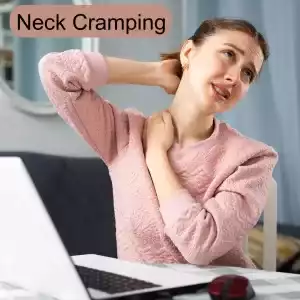
Writer’s cramp? Foot cramps and spasms in your calf muscles? Cramps that cause your toes to curl up or big toe to stick up? These are signs of dystonia, a disorder that causes muscles to contract, causing painful spasms and uncontrollable twisting of body parts. Acupuncture can help relieve symptoms of dystonia and reduce cramping.
Dystonia is a movement disorder that can affect one part of the body, such as the hand, or several parts of the body, causing painful cramping and involuntary muscle contractions.
Dystonia most often affects the hands, feet, and neck (cervical dystonia or neck dystonia). When the cramping only happens in one area, this is known as focal dystonia, i.e. focal dystonia hand, or focal hand dystonia.
Acupuncture can help relieve symptoms of dystonia without injections or surgery.
Top 5 Kinds of Dystonia
Dystonia muscle cramping and spasming can happen in various parts of the body, including:
- Neck (Cervical Dystonia) – spasm pulls the head to one side forward or backward.
- Hand – usually triggered by a certain activity, like writing, playing an instrument, or playing golf.
- Jaw – (Oromandibular Dystonia) – causes trouble with chewing, swallowing or drooling, can happen concurrently with cervical dystonia.
- Eyelids (Blepharospasm) – spasms cause the eyelids to close, can also feel like dry eyes, sensitivity to light. Can be triggered by light, screens, and stress.
- Vocal Cords (Laryngeal Dystonia) – strained voice, only able to speak in a whisper.
For some people, dystonia does not cause pain, while for others, it can become increasingly painful. In some cases, dystonia may plateau; in others, it gets progressively more severe.
Over time, some types of dystonia can lead to the deterioration of joints and arthritis.
What Causes Dystonia?
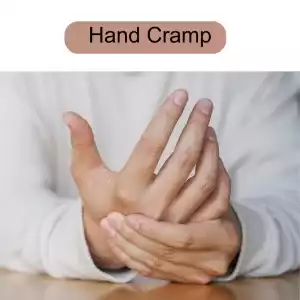
Medical science is not entirely clear on the specific causes of dystonia. There may be some genetic predisposition for dystonia. Some types of dystonia show up without any seeming correlation to other issues (primary dystonia). Other kinds of dystonia manifest as symptoms of another disorder affecting the nervous system.
Muscle spasms can be a symptom of several different disorders, including:
- Huntington’s disease
- Parkinson’s disease
- Stroke
- Brain injury or brain tumor
- Encephalitis
- Tuberculosis
- Carbon monoxide poisoning or heavy metal poisoning
Some types of dystonia can be brought on by a specific physical activity. Mental, emotional, and physical stress can also trigger an episode of dystonia cramping.
Some studies have suggested that there is a problem with motor programming, or a deficiency in the motor cortical network of the nervous system.
Treatment for Dystonia
The most common form of treatment for focal dystonia, such as the kind that causes “writer’s cramp,” is botulinum neurotoxin (BNT or Botox) injections. This is a localized treatment that helps relieve symptoms by blocking the release of chemicals involved in muscular contractions.
Patients feel their muscles relax within a few days or a week. The results of this treatment typically only last for a few months, and then another injection is needed.
Deep brain stimulation (DBS) is a surgical method used to treat dystonia. This involves the implantation of a stimulator that is somewhat like a pacemaker; it is controlled remotely and stimulates parts of the brain that affect muscular contractions.
Acupuncture can be a good alternative treatment modality for reducing the muscle spasms associated with dystonia.
Can Acupuncture Help Dystonia?
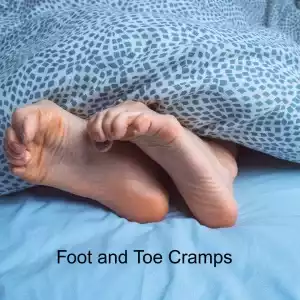
TCM theory views most health issues as being related to internal or external pathogenic forces causing imbalance within the organ systems. Organ systems in TCM are interrelated in ways that may seem counterintuitive from the “Western medicine” point of view. For example, in TCM, the actions of the muscles and tendons are related to the liver system.
Pathogenic forces like wind, damp, and heat can arise or attack the organ systems and cause problems. In the case of dystonia, excess wind in the liver affects the tendons and muscles, causing them to be overactivated.
In some cases, dystonia is triggered by emotional stress. If a patient is experiencing anxiety or depression, then that is also a factor that needs to be addressed.
Thus, the acupuncturist will create a treatment protocol designed to use different TCM modalities to address the root cause of the problem and the symptoms. Acupuncture to treat dystonia will address the liver wind and also be used to help relax the muscles. Treatment can also focus on relieving stress and balancing the person’s emotional state.
Acupuncture treatment is often used to help stimulate muscle tone. In cases of dystonia, we will use acupoints on the meridians related to the affected muscles as a way of both suppressing muscle tone and activating it. Some of the muscles related to the area that is cramping up might be hypertonic (tight and rigid), while others might be hypotonic (not active or offering resistance).
One study that looked at acupuncture treatment for cervical dystonia used electromyogram to measure muscle activity, and it showed that shallow placement of acupuncture needles decreased excess activity in the muscles.
Another study looked at patients who had been receiving Botox treatment for their cervical dystonia. They then received a series of 6 sessions of acupuncture treatment. All of the patients reported improvement and two-thirds of the patients intended to continue acupuncture treatments for management of their condition.
Gua sha and other forms of Chinese massage can also be used to help with dystonia.
Moxibustion or moxa, which is a warming herb that is burned near the affected area, can also be helpful to relieve cramping.
Acupuncture Near Me for Dystonia
Dystonia can be a serious disruption to your daily life and activities, making you feel out of control in your body. In some cases, dystonia causes serious pain. If you have been experiencing severe muscle cramping in specific areas, please do not hesitate to reach out to us at Art of Wellness for help. Drs. Tan and Cai have over 35 years of experience helping to treat conditions of all kinds that affect the nervous system and cause musculoskeletal problems.
*This article is for education from the perspective of Traditional Chinese Medicine only. The education provided by this article is not approved by FDA to diagnose, prevent, treat and cure human diseases. It should not stop you from consulting with your physician for your medical conditions. Traditional Chinese Medicine is based on Qi, which is an invisible force that usually cannot be observed by modern science. Because science focuses on testing ideas about the natural world with evidence obtained through observation, these aspects of acupuncture can’t be studied by science. Therefore acupuncture and Chinese herbs are often not supported by double-blind, randomized trials, and they are considered alternative medicine therapies in the United States.
Can Acupuncture Help Bad Breath?
By Qineng Tan, L.Ac., Ph.D. and Xiaomei Cai, L.Ac., Ph.D.

Dry mouth, coated tongue? Bad taste in your mouth, breath is always bad? There may be a deeper reason behind halitosis. Acupuncture and TCM can help correct the internal imbalances that are the root cause of bad breath.
How To Get Rid of Bad Breath
Looking for how to get rid of bad breath? Conventional medicine often sees bad breath as a dental issue, related to oral hygiene, gum disease, and bacteria on your tongue and in your mouth.
Recommendations for treating bad breath typically include using antibacterial mouth rinses and toothpastes, scraping your tongue, and flossing.
But what causes bad breath and dry mouth?
Bad Breath Causes
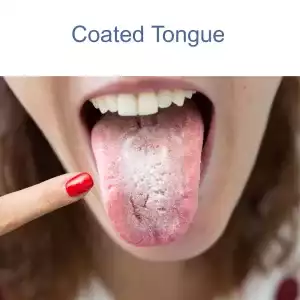
There are many health conditions that can cause bad breath, including:
- GERD – with acid reflux, some of the contents of the stomach come back up into the esophagus, which can smell strong.
- Diabetes – contributes to gum disease and bacterial growth in the mouth because of high glucose levels and poor blood flow to gums.
- Liver disease – breath may have a sulfurous, rotten egg smell, because toxins are not being adequately filtered by the liver.
- Kidney disease – can cause a metallic taste in the mouth, because minerals are not being filtered out through the kidneys.
- Sjogren’s Syndrome – parotid gland dysfunction leads to dry mouth.
- Sinusitis – mucus from sinus infection can smell bad as it drips into the back of the throat.
- Tonsillitis or tonsil stones – infected pus around the membranes of the tonsils can smell.
Other symptoms that often accompany bad breath include:
- Burning sensation on the tongue
- Need to clear your throat all the time
- Buildup on teeth, coated tongue
- Thick saliva
- Bad taste in mouth: metallic taste, sour taste, or bitter taste
Addressing these health issues can help clear up halitosis. But, what if you are experiencing frequent bad breath, and none of these health problems are the cause?
Underlying Causes of Bad Breath

According to TCM theory, bad breath usually arises from imbalances in the internal organ systems. Acupuncture treatment and herbal remedies can address the root causes of bad breath, so that it doesn’t come back.
In TCM, we consider “heat,” “wind,” “dampness,” “dryness,” and so on to be pathogenic factors that can either get into the body from external causes, or arise within the organ systems due to imbalances in Yin and Yang energies, or the obstruction or stagnation of Qi (life force energy).
Dryness and heat are the primary pathogenic factors that might lead to bad breath becoming a problem.
These words sound metaphorical, but they describe the nature of how problems occur within the human body and produce various symptoms. “Fire” or “heat” produces redness, swelling, eruptions of red bumps, thirst, excessive acid, etc.
When we say that pathogenic factors can arise from within, we are also acknowledging that emotions affect our physical and mental health, and vice versa.
Liver fire, or excess Yang energy in the Liver, for example, can arise due to dietary habits, like too much spicy food, or changes in weather, like warming temperatures in the springtime.
Liver heat is also related to feelings of anger and frustration. So, a lot of emotional stress and repressed anger can lead to liver fire problems.
Hot weather can contribute to feeling irritable. We must look at all sides of the problem in order to treat Liver fire and reduce uncomfortable symptoms, like trouble sleeping, and dry mouth.
Patterns of disharmony that can lead to bad breath as a symptoms include:
- Dry Intestine – leads to constipation and dry stool, dry throat and mouth, dizziness, hemorrhoids
- Stomach heat – thirsty all the time, craving for cold drinks, hungry all the time, canker sores, stomach pain, acid reflux, vomiting, feeling hot, acne breakouts
- Excess phlegm – tightness in chest, brain fog, dizziness
Sometimes one imbalance can lead to another. For example, liver fire can lead to fire in the lungs, causing chest pains and respiratory problems. Liver fire moving into the heart can cause angry outbursts, dry throat, and a bitter taste in your mouth.
TCM Nutrition to Address Bad Breath
Rather than simply telling you not to eat garlic, your acupuncturist will talk with you about eating the right foods to cool down the specific type of heat that is affecting your health. In TCM, we view certain foods as being “warming” or “cooling.” Eating more cool and neutral foods and avoiding heat-producing foods can help with halitosis.
An acupuncture practitioner will also assemble an herbal formula designed to address the organ system imbalances that seem to be causing problems.
Acupuncture Near Me for Bad Breath in West Los Angeles
Having bad breath can impede your social life and even your career. Experiencing dry mouth on a regular basis is very uncomfortable. It is important to address these issues, as they are likely an indication that there is something happening deeper under the surface. Please do not hesitate to reach out to us at Art of Wellness Acupuncture in Los Angeles, so that we can resolve this issue and help you feel better and more confident in your day to day life.
*This article is for education from the perspective of Traditional Chinese Medicine only. The education provided by this article is not approved by FDA to diagnose, prevent, treat and cure human diseases. It should not stop you from consulting with your physician for your medical conditions. Traditional Chinese Medicine is based on Qi, which is an invisible force that usually cannot be observed by modern science. Because science focuses on testing ideas about the natural world with evidence obtained through observation, these aspects of acupuncture can’t be studied by science. Therefore acupuncture and Chinese herbs are often not supported by double-blind, randomized trials, and they are considered alternative medicine therapies in the United States.